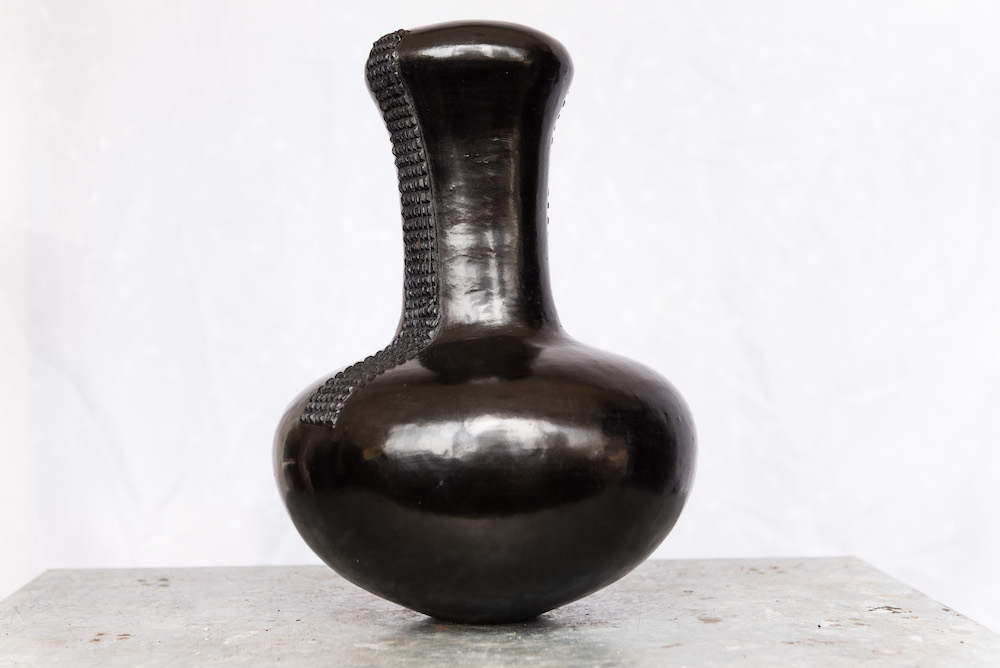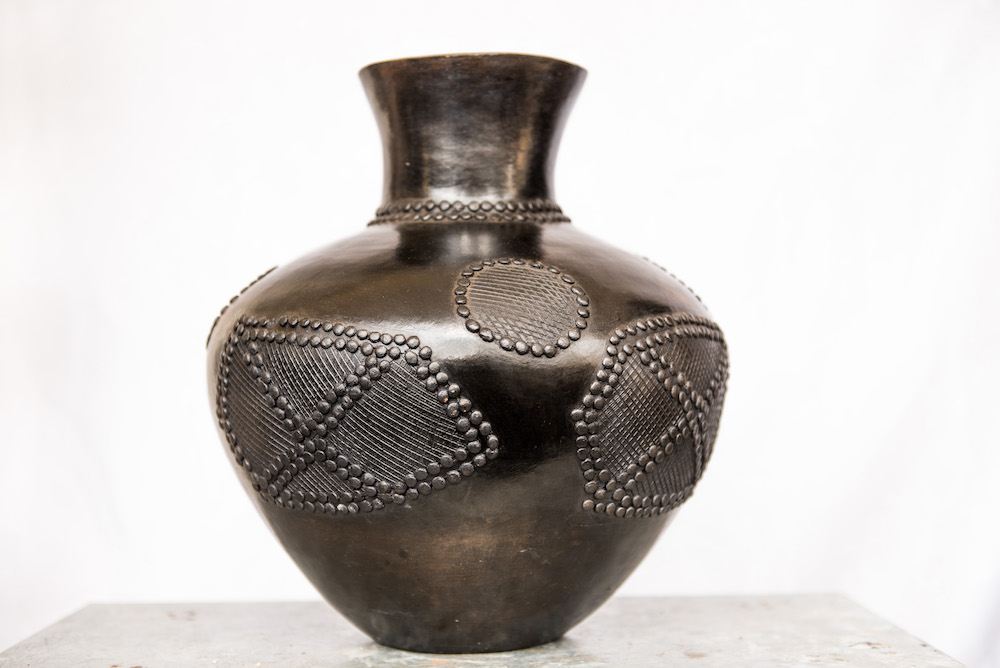Spiritual work: Intricate designs decorate Jabu Nala’s take on Zulu clay pots.
There are five izinkamba (Zulu ceramic pots) of cultural significance. All five have to do with the consumption of home-brewed beer or amasi (milk curds). A sample of Jabu Nala’s oeuvre, decked out in various stages of preparation in her Yeoville flat-cum-studio shows that she is versed in all these as well as in the art of what she simply calls vase-making.
“With this particular craft, you can alter the upper regions of the pot but the base has to show that it is still ukhamba,” a ceramic pot.
Nala’s arresting workmanship – developed from an apprenticeship in the 1970s with her famed ceramicist mother, Nesta Nala – is capped by intricate designs called imilobo, which can serve both aesthetic and practical purposes.
“Most come from the imagination but there are also amasumpa”, representations of beads that tie these pots to other ceremonial uses such as wedding gifts.
For Nala, the pots are a poetic, connective thread to her lineage, as well as a conduit for spiritual meditation. Nala still has most of her clay brought to her from the same rivulet and mountain where her mother and grandmother gathered it.
“My mom and her mother before that would mix the clay from these two sources to give it a specific consistency, but it was also of two different shades,” she recalls.
“I remember watching how, with each stroke in the design phase, the tone of the pot would change in rhythm to her movements. I remember being hypnotised by the experience.”
Nala’s techniques have not changed with time. She prefers to arrive at precision from the sensory experience of handling the clay as opposed to weighing it. Nala’s work is laborious, yielding only about six fully-fledged pots in a productive week. There are times when she also has to wait for her prized clay to arrive, creating frustrating lulls.

Perhaps this is why, as opposed to a soothing and therapeutic experience, Nala speaks of the handling of clay and the process of pottery as a moving, spiritual one.
“There are designs I have done without having seen them, only to find them in some reference books,” she says.
She points to a three-mouthed pot she made, whose design she later encountered in a book of photographs of very old pots.
The inspiration for her work often comes “in the quiet moments, like when I am anxious to sleep, a design will come into my head”.
Nala says her early childhood foray into ceramics flouted cultural mores, as pot-making was traditionally the preserve of older women.
In her family, there was also a shift from doing the craft for purely cultural reasons into harnessing its commercial potential.
“My grandmother would always fire the pots away from the house, because she had a home full of young women. We’d accompany her and leave her there.”
Although Nala does not fully explain these restrictions that frowned on young women’s handling of clay, she says they were tied to beliefs around the sacredness of the kraal and the milking of cows.
Perhaps in this sense, Nala and her lineage of matriarchs were striking a blow against patriarchy.

Today, she stands predominant when ceramic pot-making in South Africa is mentioned.
But Nala is a reluctant interviewee because of the exploitation her mother often had to endure at the hands of anthropologists, art historians, gallerists and dealers.
Refusing to pose for a photograph, Nala says that, as her mother’s stature grew, she would often watch people descend on their home where her mother would be asked to make izinkamba for various documentarians, who often exited the yard without even a gesture of thanks for her goodwill.
“A lot of people have got rich off my mother’s name, so I am circumspect in interviews,” Nala says.
Kim Sacks from Kim Sacks Gallery in Johannesburg, a prime conduit for Nala’s work, says Jabu’s mother was “exceptional” but Jabu is “extraordinary”, summing up her gifts as ancestrally channelled.
On Nala’s fortunes, Sacks is more circuitous, saying “Jabu earns more money from ceramics than most people now and she gets into international markets, where she can bring in $2?000 or $3?000 dollars a pot”.
Nala is wary of gallerists and is working with her daughter, Ncamisile, to try to maintain control of every aspect of her craft. She is preparing for a showcase at a craft market in Germany as a result of the partnership she is forging with her daughter.
“A lot of my customers want to meet me in person, but gallerists usually discourage that for fear that we will bypass them and begin to earn what is rightfully due to us,” Nala says.
To purchase Nala’s work call 0743270133